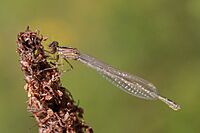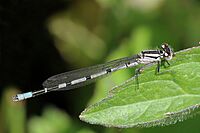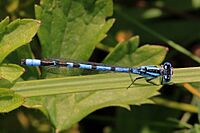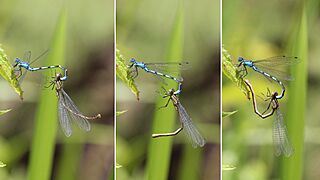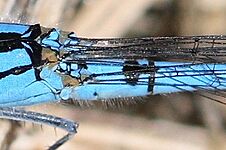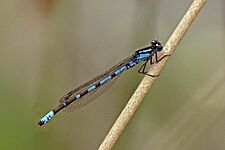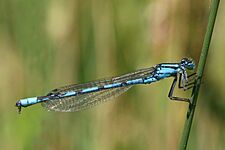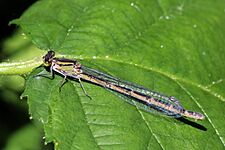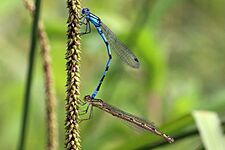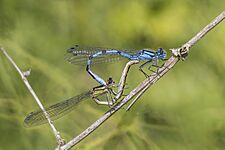Common blue damselfly facts for kids
Quick facts for kids Common blue damselfly |
|
|---|---|
 |
|
| Young adult male | |
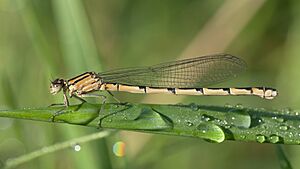 |
|
| Young adult female | |
| Conservation status | |
| Scientific classification | |
| Synonyms | |
|
The Common Blue Damselfly (also called the common bluet or northern bluet) is a beautiful insect found in many parts of the world. You can find them in places like Russia, Sweden, Norway, Finland, the United States of America, and South Korea. These damselflies usually live in areas between 40°N and 72°N latitude.
They are quite small, growing to about 32 to 35 mm (1.3 to 1.4 inches) long. Damselflies are very important for understanding how healthy a water environment is and how it reacts to climate change.
Contents
Where Common Blue Damselflies Live
Common Blue Damselflies live in many different kinds of freshwater places. You might see them in ponds or even in wetlands that have slightly acidic water. They are considered sensitive insects, meaning they need good water conditions to thrive.
These damselflies play an important role in the food chain. They are like a middle predator, meaning they eat smaller larvae. But they also get eaten by bigger creatures, like fish and larger larvae.
Young damselfly larvae prefer to live in places with lots of plants and a complex ground structure. They spend most of their time climbing and finding food among the plants. Even though they like complex habitats, they can also live in simpler areas with fewer plants. The plants also help protect them from fish.
These larvae can live close together in shallow water without fighting for space or food. They need strong plants to hold onto when they extend their mouthparts to catch food.
How to Identify Common Blue Damselflies
Male Common Blue Damselflies are a bright cerulean blue color with black markings on their bodies. Females, however, can have different colors.
Some females, called andromorphs, look a lot like the blue males. But they have more black patterns on their bodies. Other females, called heteromorphs, are more of a brown or greenish-brown color and do not look like the males at all. Scientists think these different female colors help them avoid too much attention when they are near the water to lay eggs.
It's easy to mix up the Common Blue Damselfly with the Azure damselfly (Coenagrion puella). But here's a trick: the Common Blue Damselfly has more blue than black on its back and thorax. The Azure damselfly has more black. Also, the Common Blue Damselfly has a special spot with a line below it on the second part of its thorax.
Another way to tell them apart is to look at the side of their thorax. The Common Blue Damselfly has only one small black stripe there. Other blue damselflies usually have two stripes.
Common Blue Damselfly Life Cycle
The life of a Common Blue Damselfly starts in freshwater as a larva. They spend most of their lives in this stage. How long they stay as larvae depends on the temperature, light, and how much food is available. When it gets cold, the larvae can go into a resting state called diapause instead of dying. This resting period can affect how big the adults become in the next season.
Because these damselflies are flexible, they have two different life cycles depending on where they live. Some have a univoltine cycle (one generation per year), and others have a semivoltine cycle (two years for one generation). The further north you find these damselflies, the more likely they are to take two years to grow. This longer development time allows them to become larger adults.
Once the larvae turn into adults, usually between May and August, they have a short time to eat. Then, they need to find a mate to start the next generation of larvae. When they first emerge, there are usually an equal number of males and females.
The male and female fly together over the water. The female then lays her eggs inside a suitable plant, just below the water's surface. The eggs hatch into tiny larvae, also called nymphs. These nymphs live in the water and eat small aquatic animals. When they are ready to become adults, the nymphs climb out of the water onto a plant stem and shed their skin, transforming into a damselfly.
Common Blue Damselfly Behavior
The larvae of Common Blue Damselflies can eat many different kinds of food. This helps them live in various habitats. They can even eat prey that is relatively large, but they usually go for prey that doesn't move much, making it easier to catch.
Male Common Blue Damselflies are quite active compared to other damselfly species. Sometimes, they might even try to mate with other similar damselfly species, like the Blue-tailed damselfly (Ischnura elegans) or the Azure damselfly (Coenagrion puella). This usually happens when they can't find a mate of their own species.
For someone new to damselflies, it can be tricky to tell them apart from Azure damselflies. Common Blue Damselflies usually fly low through reeds and often fly out over the water. They are also a brighter blue color than Azure damselflies.
How Humans Affect Damselflies
Pesticides have a big impact on Common Blue Damselflies because these insects are very sensitive. Pesticides get into the water from rain washing them off land or when they are added directly. When damselfly larvae are exposed to pesticides, they are less likely to successfully change into adults. The longer they are exposed, the worse the effects. Pesticides can also change how adult damselflies behave.
Gallery
See also
- Azure damselfly, a similar looking species
- Ischnura heterosticta, a similar Australian damselfly
- List of British dragonflies



